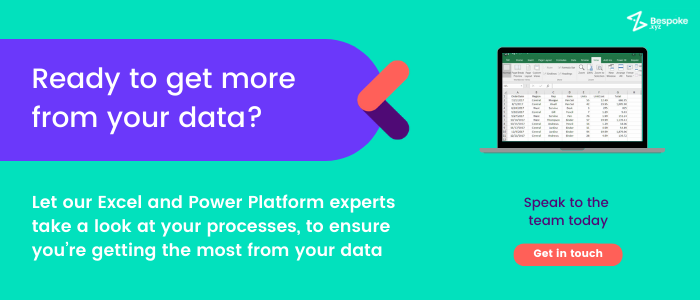Get a callback from our team within 20 minutes during business hours.
You’ve probably heard the saying, “It’s not what you have, it’s how you use it.” Never is this potentially more true than when we’re dealing with data.
Data is a collection of facts and information turned into a form that’s easier for us to process. It can be numbers, words, measurements or even just observations. Consumer data often holds many insights about your customers – from what they like to buy to how or even when – and can help us build more positive customer relationships.
Gathering consumer data, however, is only one part of the equation – what matters most is how you use it. In today’s tech-led world we are being overwhelmed with data, and if you don’t know what to do with it, your competition will.
Here at Bespoke, we help businesses efficiently process their data to unlock powerful advantages. We do this in five ways:
Data transformation involves changing the format, structure, or values of raw data in order to make it easier to process (see below). It may be constructive (like adding or replicating data), destructive (deleting records and folders), aesthetic (standardising values and labels), or structural (such as moving and combining columns in a database).
We transform data to make it more organised and easier for both humans and computers to use. It helps to improve data quality later down the line (see Data Validation) and protects against potential problems like null values, unexpected duplicates or incompatible formats.
Data transformation might also include data integration – the combination of technical and business processes to combine data from various sources into meaningful and valuable information.
All of these transformative processes are crucial to effective data management, which is the practice of collecting, keeping and using data securely and cost-effectively.
More data of course means more processing, which can significantly add to your company’s workload. That’s where data automation comes in.
Data automation allows mundane data handling tasks to be run effortlessly in the background, without demanding precious employee time. It can be achieved using business applications such as Excel and Power BI, or even a bespoke solution created specifically for you.
Different types of data automation might include data capture automation (making it easier to collect, store and organise large amounts of data at once); automating business processes or workflows, and automated data uploads (leading to increased accuracy and saved time).
Data visualisation is the presentation of data in a graph, chart, diagram or other visual format. It is incredibly important for business dashboards as a way to communicate relationships between the data and allow trends and patterns to be easily seen. Machine learning makes it easier to conduct business analytics such as predictive analysis, which can then serve as helpful insights for future goals.
Data virtualisation, meanwhile, allows an application to retrieve and manipulate data without requiring technical details such as the data’s format or physical location. Similar to data visualisation, the goal of data virtualisation is to create a single representation of data from multiple, disparate sources, without having to copy or move the data.
Data processing is when data is collected and translated into usable information. It is important for this to be done correctly so as to avoid negatively affecting the end data or product.
Starting with the data in its rawest form, data processing converts it into a more readable format (such as a graphs or documents, etc.), enabling company employees and stakeholders to utilise the data for their own data analytics projects.
This type of information processing is typically done using machine learning algorithms, though the process may vary depending on the source of data being processed and its intended use.
Data validation involves checking the accuracy and quality of source data before using, importing or otherwise processing data. When moving and merging data from different sources and repositories, it’s important to make sure it conforms to business rules and doesn’t become corrupted due to inconsistencies. The goal is to create data that is consistent, accurate and complete, to prevent data loss and errors during a move.
Different types of validation depend on destination constraints or objectives. Data validation is also a form of data cleansing.
At Bespoke, we have a team ready to help you prepare to work with your data and understand the opportunities available and even do a data healthcheck. Just shoot us an email to set up your free consultation.
